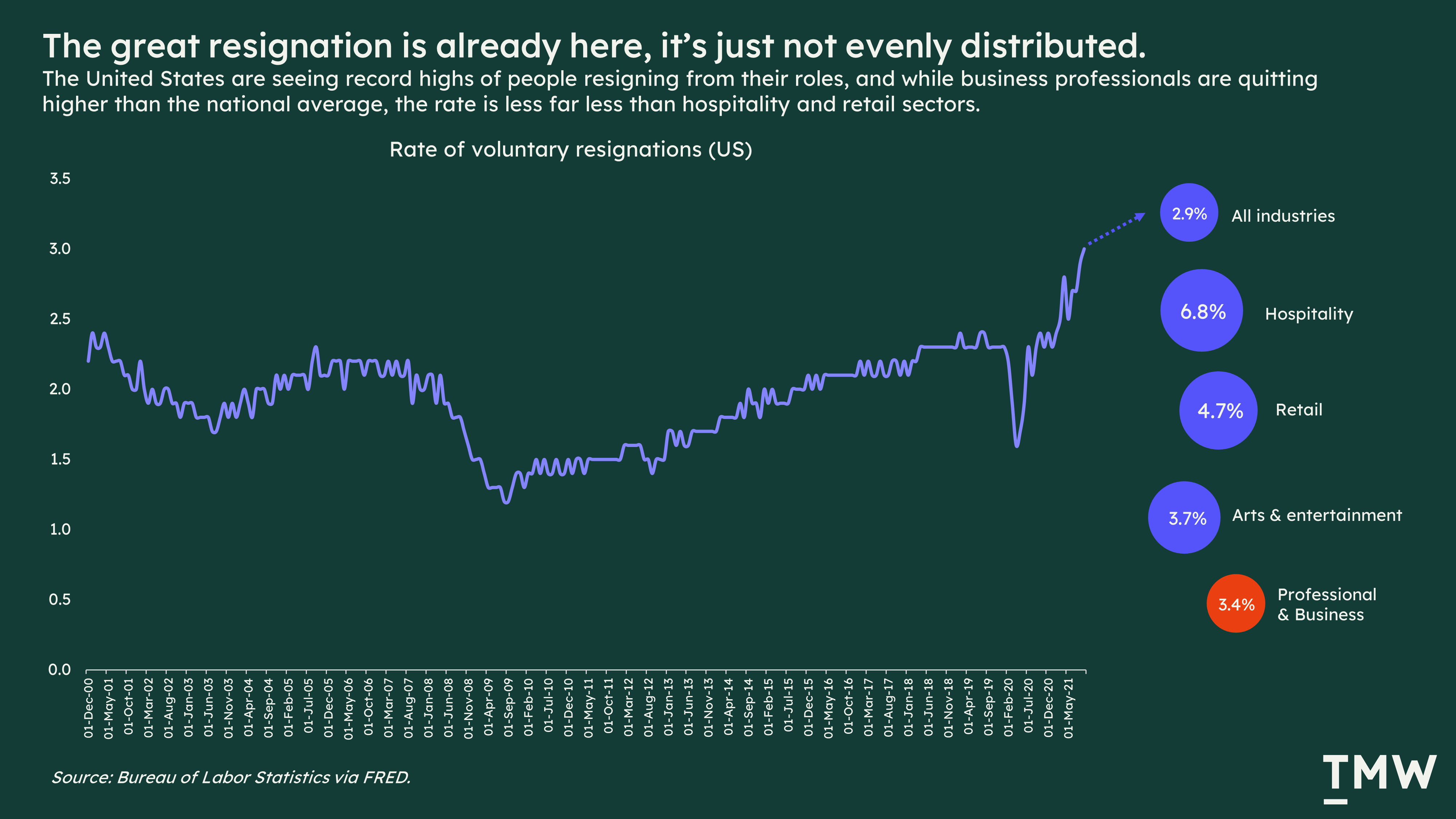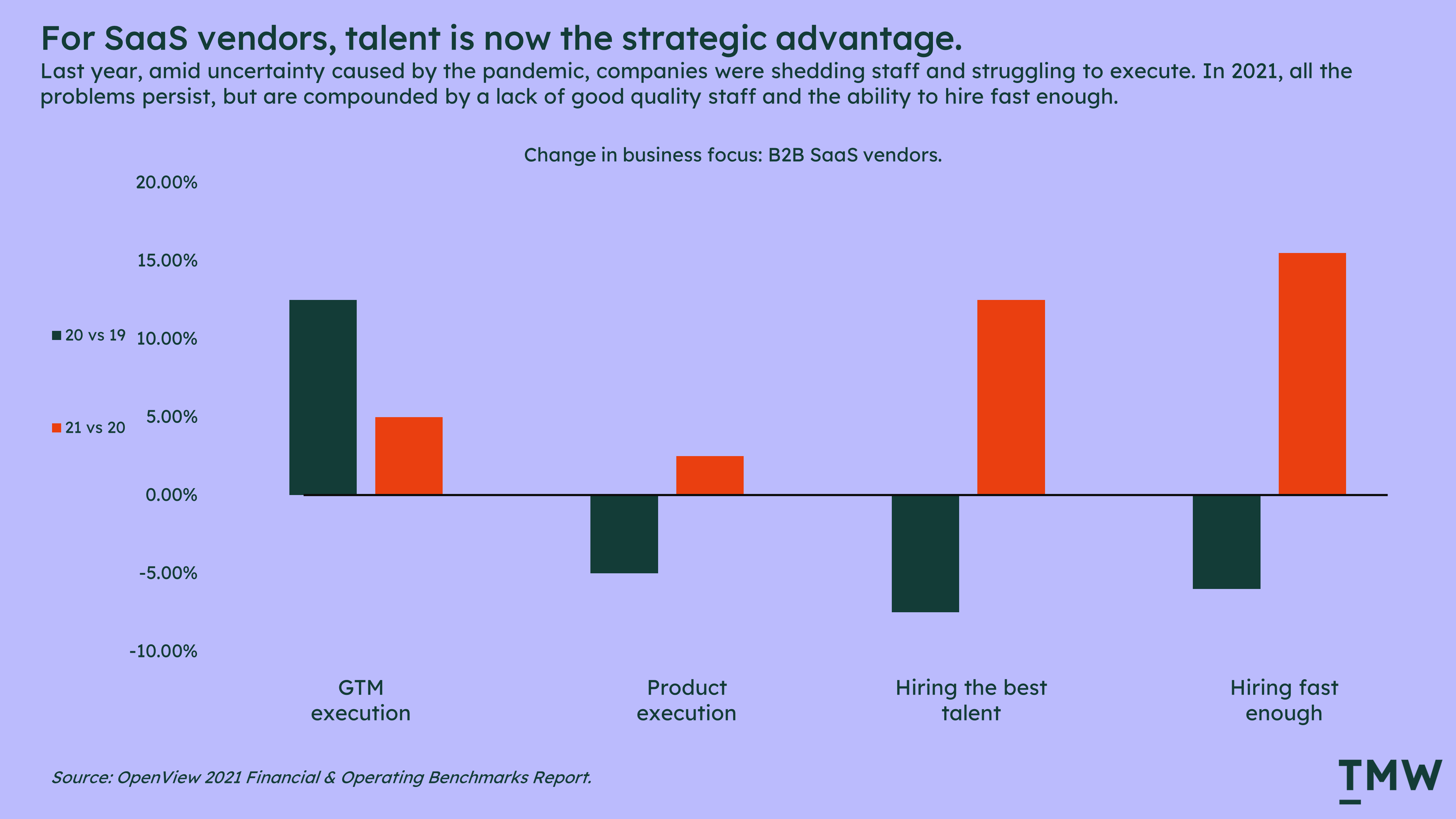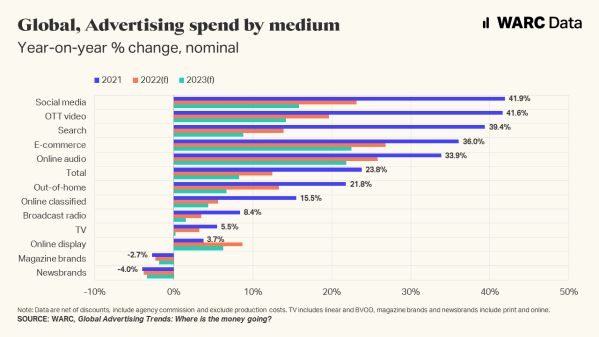TMW #066 | Martech talent is a supply-side problem, the advertising triad and Amazon’s interest in HubSpot
Welcome to The Martech Weekly, where every week I review some of the most interesting ideas, research, and latest news. I try to look to where the industry is going and make sense of it all.
👋 Why you should sign up
TMW is the fastest and easiest way to stay ahead of the Martech industry. Sign up to get the full version delivered every Sunday for this and every TMW, along with an invite to the TMW community. Learn more here.
Here’s the week in Martech:
- Martech talent is a supply-side problem: The great resignation from the viewpoint of a marketing technologist.
- The advertising triad: Over half of all advertising spend will go to just three companies: Amazon, Meta, and Alphabet.
- Amazon & Hubspot? There are rumors of a $40 billion acquisition.
- Everything else: Zendesk’s expansion, changing the guard at Twitter, data cleanrooms explained, the best way to think about NFTs, Shopify breaks another record, Disney and holdout groups, AWS gives AI a no-code solution, and alternatives to Spotify wrapped!
✍ Commentary
Martech talent is a supply-side problem. I have been debating to write something on the great resignation/revaluation/reconsideration for about three months now. This is mostly because of how noisy and confusing the entire topic has become. So, dear reader, if you’d indulge me, here are a few thoughts on the global talent challenges as I see them play out in the marketing technology industry.
The first question we need to ask ourselves amid the mainstream narrative of “everyone is quitting their jobs” is how much the great resignation is impacting the marketing technology industry. The numbers for our specific niche are unclear, but what I can infer from wider reports are that although voluntary resignations are at historic highs in the US, the professional and business categories are significantly lower than other industries, such as hospitality and retail. Marketers are not quitting in the kinds of droves seen elsewhere.

This is why we need to rethink the idea of the great resignation in the Martech space. It’s fairer to say that the pandemic has accelerated the demand for digital experiences, creating a supply-side challenge for experienced talent. It’s more likely that your staff are being poached by other firms than they are rethinking their life goals.
The supply chain of the digital economy has seen enormous pressures put upon it as the pandemic triggered entirely new segments of customers to transact online for the first time. The intricate web of technology and data solutions that support necessary digital experiences like eCommerce or online services is impacted by upstream changes in consumer behavior. Data infrastructure providers, marketing automation solutions, CMS products, data warehousing, advertising networks, and many other categories in Martech along with the agencies and consultancies that support brands have all seen increased market activity.
All of this growth requires staff to build solutions, sell to customers, manage clients, and create product roadmaps. We’re technologically rich, but knowledge worker poor. So much so that for many B2B SaaS vendors, the balance has shifted from focusing on executing to hiring high-quality people quickly in 2021.

This should tell you that the underlying infrastructure isn’t really coping well with the kinds of demand that a global pandemic has wrought. In other words - the customer wants us to give them the future of digital experiences faster than we can create them.
It's never been a better time to be working in the cross-section between marketing and technology. It takes a special kind of person to enjoy the technical complexities and the creative challenges that Martech demands from staff. For the average marketer, understanding strategy and building a compelling market proposition is only 30% of the job. Learning the technology, analyzing the data, and building a solution is all in the marketer’s wheelhouse now. This is why there’s a supply-side problem in Martech, there’s just not enough people with the specific knowledge, interest, and skills in the marketplace.
For hiring managers worried about losing their staff, there are really three paths to address these challenges. All of them aren’t great, but some a greater than others. These are:
(1) Paying more for new and existing staff
(2) Opening the talent pool
(3) Automating as much as possible
(4) There’s a fourth option, but I’ll leave it to the end
Paying more for staff seems to be the most viable pathway leaders can take in response to what may be two to three years of staff shortages to come. Some companies, Like Atlassian, are now offering engineers more than $300 thousand salaries for people just starting out, others are pitching more staff equity than ever before and promoting perks like remote work and endless leave to attract talent. This might be interesting enough for many staff to jump ship but paying more in this economy seems to be table stakes with what everyone else is doing. It’s hard to differentiate with a better salary.
The unfortunate reality of the Martech industry is that it’s inherently entrepreneurial. Rarely is a role clearly defined and predictable. Most of the time you’re building solutions in ways not done before, addressing critical business challenges, and finding unique and creative ways to help brands grow.
All the above are traits of successful entrepreneurs, and the double-edged sword of the great resignation is that consumers are online now more than ever, creating new markets for talented staff to launch their own companies. Offering someone a $10k salary bump to stay on is a hard sell compared to the promises of start-up riches. Perhaps there’s more opportunity in incubating some of these fledgling entrepreneurs instead of trying to tie them down?
Another unfortunate path one can take is opening the talent pool to younger and less experienced practitioners. The challenge is that the typical marketing degree doesn’t really prepare someone to enter the world of Martech. And hiring underprepared staff can be a high-risk and expensive game where figuring things out on the fly can lead to millions of dollars lost in revenue or a bad vendor implementation.
If you’re brand side, working for a vendor or a consultancy, the consistent problem in the industry is that there’s no formal pathway to the work. Usually, it’s a mix of apprenticeships, a good manager, or figuring it out in a start-up environment. Companies like the Martech Alliance offer some specific courses in marketing technology, which is a great start at addressing an enormous economic gap, but more needs to be done. The talent crisis will continue to compound until industry leaders start building onramps onto Martech and inroads with universities.
The third path is to automate the job completely. There’s a lot of this already happening in the content and advertising space. Try Pencil is one AI company that churns out advertising copy for social media at scale, and there are now plenty of copywriting and design bots that can start to take some of the burden and drudgery away from marketers. This lowers headcount, but as I’ve mentioned in the past – it puts more of the creative control in the hands of AI, which is a risky proposition for anyone who’s reporting on revenue outcomes.
A telling signal of increasing talent automation in the industry is the number of productivity and process apps that are being acquired by Martech specific vendors. Adobe, Salesforce and just this week Optimizely have acquired marketing operations software. This is both in response to the process and people challenges of extracting value from Martech tools and the need to automate as much of the worker as possible.
If an experience platform like Optimizely can also offer brands cost savings on headcount (and recruiters) by implementing a level of process automation, that’s a strong value proposition to keep them around for another year. In the same way that the pandemic was a trigger event for online shopping, the lack of skilled talent is a trigger point to automate the majority of a marketer’s role.
The Martech industry is only growing, and the lack of education and skills onramps for the industry is compounding the problem in a once-in-a-lifetime situation of exponential demand for online experiences. Aside from paying more, hiring underprepared people, or automating as much as possible, there are other ways to address the challenges.
I would offer this one piece of advice – build a vision for your company/product/team, and make it compelling enough for people to stay along for the ride. Changing jobs in Martech is often like moving from driving a car to learning how to ride a motorbike. It takes years to get up to speed on what is happening in a company when you look at all the data, technology, process, and strategies that need to be learned. For most, it takes at least five years to enact meaningful change or deliver something great for your customers. In this way, the best talent will want to see something through before they call it a day. Making sure that “something” is worthwhile is your job. Links: Dropbox on the great resignation. The great re-invention. Resignation stats (US). Global Martech industry growth stats. Openview 2021 operating benchmarks report. Atlassian’s approach. WEC on the great resignation.
📈Chart Of The Week
The new advertising triad. According to WARC, over half of all advertising spend (now a $700+ billion-dollar market) will go to just three companies: Amazon, Meta, and Alphabet. This is reflective of the global advertising trends across channels, with social media, search, and a newer entrant – eCommerce platform spending seeing the greatest growth. It’s important to consider the rapid scale Amazon is achieving in the search domain, and the impact it will have on brands that decide to not sell on the Amazon marketplace. Link

📰 Latest Developments
Amazon & HubSpot? There are some rumors running about that Amazon might be looking to acquire the CRM and marketing automation company. The deal could be worth upwards of $40 billion according to Business Insider. This could be Amazon’s biggest move into the marketing automation space yet. HubSpot has reached a milestone of $1 billion in revenue recently, which means neutralizing future a competitive threat in the CRM space might make some sense. (More to come in next week’s commentary). Link
Zendesk is expanding its footprint. The company has announced an acquisition of Momentive, the parent company of the much beloved/hated SurveyMonkey. For years Zendesk had the corner of the customer service market, but they now want to expand into customer analytics. The value of the acquisition is mostly in the ability to integrate survey answers with customer service history and real-time identification of customer satisfaction, which would be an advantage over customer analytics platforms that can’t facilitate an experience. Link
A change of the guard at Twitter. Jack Dorsey has resigned as the social media company’s part-time CEO and several senior roles in the company across engineering and creative have also departed. After almost a decade of the company sitting on its laurels, there’s been a staggering number of new features shipped this year, like a subscription offering, a Clubhouse clone, and a creator mode. Despite this, Jack’s departure sees the company leave no meaningful impact on the stock price since he took to the helm. Links: Announcement. Analysis.
📚 Reading
CDPs are not the future? An interesting piece arguing that CDPs are not the future of data infrastructure. This is more of a technical argument about speed to market, how the technology disrupts a single view of customers, and limitations around innovation and flexibility. It’s a fitting pair with last week’s commentary on CDPs. Link
Cleanrooms explained. In the wake of cookie deprecation, much of the focus is on cookie alternatives while Amazon, Disney, Snowflake, Omnicom, and other major trading platforms are building data cleanrooms. This overview from Marketing Brew is a great primer on the technology, its risks, and future. They call it the Switzerland of advertising data. Link
The best way to think about NFTs. Maybe the point of the technology is not that you “own a JPEG” or get access to some exclusive club, but rather you own a small piece of the giant cryptographic puzzle that is web3. Link
🔢 Data & Insights
Shopify merchants break Black Friday sales records (again). Over a single day, $2.9 billion in online sales were made on the Shopify platform, which is a 21% increase over 2020. This is a strong signal of the staying power of eCommerce well after the pandemic will leave us. Link
The state of marketing operations. A report from HubSpot and Mo Pros is a deep dive into the characteristics of the relatively new role of the marketing operations professional. Most people working in this role are in the SaaS industry and are likely to be between 30 and 40 years of age. Link
What the world is listening to. Spotify wrapped happened this week, and along with unleashing personalized round-ups to listeners around the world, the company also released some stats on global listening preferences. One stat that’s reflective of the impact of the streaming economy in music: The artist with the most streams in 2021 (over 9 billion), didn’t even release an album this year. Link
💡 Ideas
How Disney manages hold-out groups. The company runs a huge, complex experimentation program across several media properties. Like many media companies, high velocity and reliable testing methodologies are needed to make decisions, so the Disney team figured out how to run customer-level hold-out groups in a way that’s scalable and fast. Link.
AI goes no-code. The SageMaker Canvas was announced at the AWS re:Invent conference this week, the latest iteration of machine learning products with a layer of no-code tools. The promise is to enable anyone without any prior ML or coding experience to be able to manage the tool and apply it within a business context. Data scientists everywhere are screaming. Link
Replacing channels with an ecosystem. What’s super interesting about this interview is the concept of building a customer ecosystem to replace the traditional B2B marketing funnel. Moving away from revenue-oriented outcomes to influence and interaction-based outcomes seem to be where some of the more sophisticated brands are heading. But it’s harder to measure and the idea is not a template you can easily replicate. If for nothing else, it’s worth reading just for sentences like this: “Ecosystem-led growth and product-led growth are kissing cousins.” Link
✨ Weird and Wonderful
The Excelfluencer. This person is making six figures a day teaching the next generation how to use Microsoft Excel on TikTok. Link
The commodification of strategy. There are now thousands of strategic frameworks in circulation. This probably explains why it’s so hard to get a marketing strategy right. Link. Original essay (p36).
Alternatives to Spotify Wrapped: LinkedIn. Digital Marketing. Bank of America. Twitter.
Stay Curious,
Make sense of marketing technology.
Sign up now to get the full version of TMW delivered to your inbox every Sunday afternoon plus an invite to the slack community.
Want to share something interesting or be featured in The Martech Weekly? Drop me a line at juan@themartechweekly.com.
